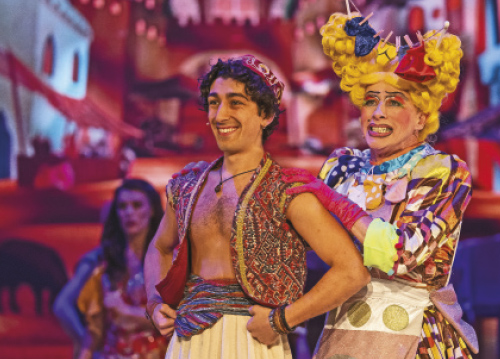
For generations of Dubliners the traditional Christmas pantomime has been regarded as the most family fun you can have in public dressed up as someone of the opposite sex.
The stars of Christmas Panto in places like the Theatre Royal and the Queens Theatre, the Gaiety and the Olympia have been household names over the years. Many of these stars and the grand old theatres who have hosted their festive antics are represented in the exhibition, A Christmas Spectacle: The Story Of Panto in Dublin, currently open in Pearse Street Library.
The origins of pantomime are found in Italian Commedia dell’arte, a type of street theatre originating in the 16th century. Stock characters in Commedia included Arlechino (a mischievous fellow, who became known later as ‘Harlequin’), Columbine (Arlechino’s lover), Pantaloon (Columbines father) and a clown character. This developed into an early form of pantomime, where the characters were spectacularly transformed by a fairy into those characters of the Harlequinade.
There are newspaper articles from as early as the first half of the 18th century referring to pantomimes in the original Theatre Royal in Smock Alley.
By the early 1820s pantomime was a popular and successful established form of theatre. The standard characters of the Harlequinade were still in use, but as time went on pantomime dames, such as Widow Twanky were introduced, along with localisation in the form of specifically Irish themes or storylines. By 1840, for example, the title of the Theatre Royal’s pantomime was, O’Donoghue of the Lakes, or Harlequin and the Leprechaun!
By the latter decades of the 19th century the tradition of the Harlequinade had waned and in Ireland, as in Britain, pantomime stories had become something that would be more familiar to us today, with indigenous and Eurpoean folk stories and fairytales forming the basis of the entertainment. Stories like Cinderella, Dick Whittington, Aladdin and Robinson Crusoe were the norm from then on.
The exhibition highlights some of the brightest stars in the Dublin pantomime firmament through the years, names with which some of our readers will have grown up, like Jimmy O’Dea. O’Dea was born in 1899 in Dublin’s south inner city. Although he went on to become a legend of the Dublin stage, he was not encouraged in his chosen profession at the start. Indeed, O’Dea’s father disapproved of his acting ambitions saying “I’d rather see you in your coffin first.”
Half-taking the parental guidance, Jimmy O’Dea qualified as an optician and acted part-time at first. His early pantomime appearances included Dick Whittington in 1925 in the Queen’s Theatre. Then he set up O’D productions with Harry O’Donovan in 1927. Their first pantomime was Sinbad The Sailor in The Olympia, but they are most famous for their many pantomimes in The Gaiety.
Other stalwarts were Noel Purcell and arch pantomime bad guy, Vernon Hayden. Hayden was born in Tyrone in 1914 and was on stage from the age of four. His first pantomime role was as a babe in Babes Of The Wood. He toured with famous pantomime comedian Jim Johnson, performing a different pantomime every night for three years, which is a lot of “He’s behind you”!
However, from 1936 when he joined Jimmy O’Dea for the Gaiety Christmas pantomime, he appeared in every Gaiety panto for nearly 50 years. He was particularly noted for playing baddies saying “the more hissing and booing from the children, the more I like it”. He continued performing until his death in 1990.
A less well known historic venue for pantomime was The Abbey Theatre, which produced a number of traditional pantomimes in the early years after its foundation in 1904, but became best known for its Irish language pantomimes which started in 1945 with Muireann Agus an Prionnsa. It was attended by President Sean T. O’Kelly and the Taoiseach Eamon De Valera and produced by Frank Dermody, who went on to produce all the subsequent Abbey pantomimes until the last one in 1966, the first in the Theatre’s present day home and the last in the series as the emphasis on the Irish language became less of a focus for the Abbey.
Before it moved to its current location the Abbey found refuge when the old theatre burnt down in The Queen’s Royal Theatre, Pearse Street from 1951 until 1966. Built in 1829 and originally called The Adelphi, it was rebuilt and renamed The Queen’s Royal in 1844 and featured pantomimes from the start, and from the 1870s onwards followed the trend towards fairy tales such as Robin Hood or Harlequin Gulliver and the King of Lilliput. Household names like Noel Purcell, Jimmy O’Dea and Danny Cummins played in pantomimes here.
It would be remiss to not mention Danny Cummins or not to highlight Maureen Potter, renowned as the other half of a celebrated on-stage comedy couple with Cummins for many a pantomime in places like the Theatre Royal and in the Gaels Of Laughter revues in the Gaiety.
Potter, Twink, Brendan Grace and many others are celebrated in a fittingly fun and colourful way in an exhibition which will bring back happy childhood memories of Christmases past for many. This happy tradition continues today with the annual pantomimes in The Gaiety and The Olympia in city centre Dublin and many other fine old and new theatres in the city and around the country. Will you go? Oh yes you will!!
Aladdin runs this year in The Gaiety from Nov 24th-Jan16th www.thegaiety.ie
Cinderella runs in the The Olympia from Dec 20th-31st www.theolympia.ie
A Christmas Spectacle: The Story of Panto in Dublin runs in Pearse Street Library until the end of January 2020. Opening hours: Monday-Thursday 10am-8pm, Friday-Saturday 10am -5pm and admission is free.



